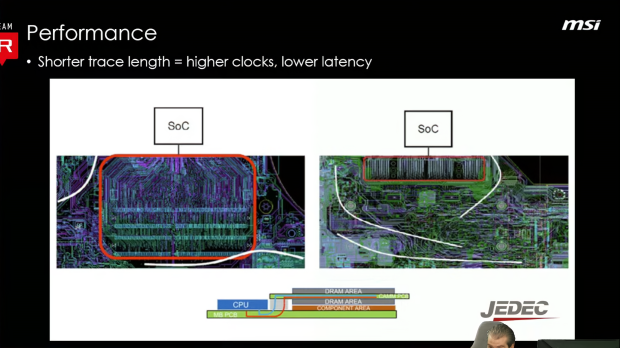CAMM2 memory modules are on their way, and will debut inside of desktop PCs in the near future, with MSI highlighting some of the benefits of CAMM2 memory. Check out their video below:
JEDEC has already made the new CAMM2 standard official, with CAMM2 memory modules for desktops marking a HUGE shift from traditional SO-DIMM memory that we’ve seen previously. CAMM2 was designed to save space on mobile platforms like laptops and smartphones, but the PC industry sees the huge potential of CAMM2 beyond just laptops and smartphones.
MSI, ASUS, and ASRock have teased their first motherboards with CAMM2 support, and now MSI went into much more detail about CAMM2 memory modules during their recent Insider Livestream. MSI points out that unlike SO-DIMM memory which has SI (System Interface) stubs embedded within the PCB of the motherboard which reduces the platform capabilities for bus speed, CAMM2’s interface is connected directly to the CAMM2 module. Both the inner and outer connections of the IMC are connected to CAMM2 modules, which provide a path to higher signal integrity, and higher performance.
CAMM2 memory modules require less signal traces between teh CPU and DIMM slots on the motherboard, which can lead to manufacturers saving money. Another benefit, is that being that closely connected directly to the CPU IMC, is that the inner and outer channels lead directly into a single CAMM2 module, allowing for dual-channel operations on a single stick of SO-DIMM where you needed to have two memory modules to get dual-channel support… that’s a big deal.
This means we’ll see higher memory capacities thanks to CAMM2, where we’re already being teased (in the links above) with 192GB+ RAM capacities with HUGE space savings. Another big point is that a multi-DIMM solution like SO-DIMM leads to higher memory capacities and dual-channel capabilities, but slower speeds as the bus capabilities take an impact feeding the information through multiple DRAM modules.

VIEW GALLERY – 13 IMAGES
This is why we see single-channel RAM runs with OC world records, as dual-channel and quad-channel DIMM setups can overload the IMC. This is why we see Mini-ITX motherboards having improved signal integrity, as the DIMMs are physically closer to the CPU socket, so there’s less latency to travel between the CPU IMC and the memory modules.
CAMM2 is just one single module that supports dual-channel mode, higher speeds but JEDEC has specified that we’ll see dual-DIMM CAMM2 designs in the future.
CAMM2 memory modules also feature a smaller PCB than SO-DIMM modules, with less materials used to make them given there’s only a single module, only a single PMIC (Power Management Integrated Circuit) is required. On a regular SO-DIMM setup, each of the memory modules features its own individual PMIC. This means we will see power savings, as multiple ICs can increase overall power consumption for the memory, and it also means that there’s less heat generated as you can run CAMM2 modules without heatsinks. Another really, really nice touch that CAMM2 delivers.

The new CAMM2 DDR5 DIMMs will consume less power, but also have improved cooling. SO-DIMM memory modules normally block the airflow to the CPU as they’re sitting directly next to the CPU socket, with faster, higher-end DIMMs featuring gigantic heatsinks.
The right-most DIMM is always blocking the rest of the DIMMs installed alongside them, but with CAMM2, those problems go away as CAMM2 memory modules lay flat. This means that the CPU receives additional airflow, with flattened heatsinks capable of being used, which will deliver great cooling to the CAMM2 memory modules.

MSI teases that the backside connector on the motherboard that supports CAMM2 memory modules features an aluminum heatsink for the CAMM2 memory, which — of course — feautures RGB lighting. The memory itself won’t have RGB lighting, but the heatsink and cover plates designed by motherboard makers will surely make them look real, real good.



MSI’s own in-house CAMM2 heatsink comes with a tool-less design, with a thermal pad on the module itself, and another on the motherboard PCB, which directs heat through to a metal-based mounting bracket on the back.
We will continue to see CAMM2 memory modules evolve over the coming months, especially as motherboard makers want new designs that step out from the norm that we’ve become accustomed to over the last few decades.